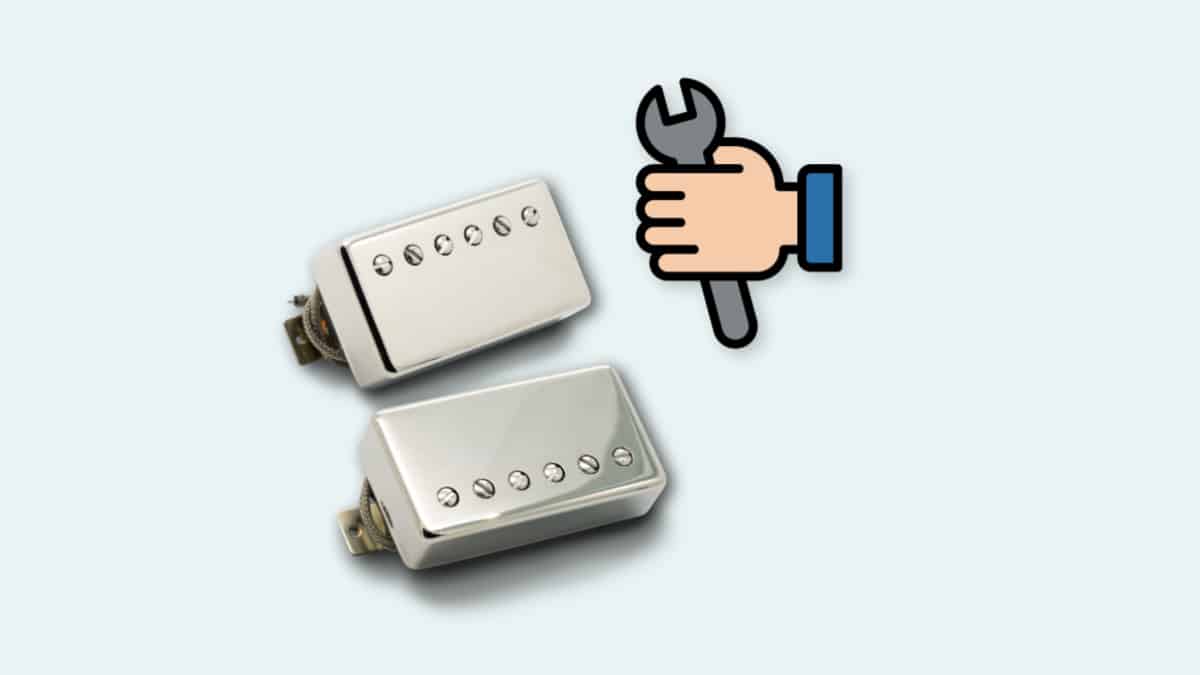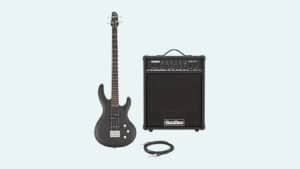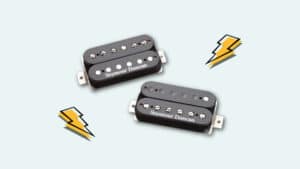Just like a microphone, a microphonic pickup processes unnecessary sounds, producing an uncomfortable tone, characterized by noise distortions.
Some of the amplified sounds usually emanate from the guitar’s body, as you are tapping or touching it.
And when the gain is high, a microphonic pickup produces an uncomfortable, squealing noise, which is high-pitched. As a result, it’s always challenging to generate clean tones on a guitar with a microphonic pickup.
To help you out, I’ll show you 3 easy ways to fix a microphonic pickup—each of them has worked for me before.
How do I Know if my Pickups are Microphonic?
1. Squeals on High Gain/Volume
A microphonic pickup generates a high-pitched squeaky sound, especially on guitars with super high-gain settings. The sound cuts through your ears, making you feel uncomfortable, just like the high-pitched sound that’s always produced by microphones. It sounds like an animal squeal.
By cranking up the volume or gain setting a little bit, you’ll be able to tell if your guitar has a microphonic pickup.
And if you touch your guitar’s body, the intensity of microphonic noise increases. In most cases, these noises may be similar to distortion effects.
While the two sounds might be easily confused with one another, distortions will give you warm clear tones, adding some punch to your music tracks.
Unlike microphonic noises, distortion effects complement harmonics with nice rhythms. For example, metal and hard-rock music features heavily-distorted tones, adding character to songs, using structured guitar riffs.
To tell the difference between distortion effects and microphonic noises, listen to the sounds generated by your guitar when it’s idle and plugged in. A microphonic pickup squeals a few seconds before you start playing your guitar.
The squealing sound might also be amplified during pauses. And once you finish playing your guitar, you might hear that sound again.
2. Excessive Noise From The Surroundings
As a microphonic pickup lays idly, it captures excessive noise from the immediate surroundings and feeds it to the amp. As a result, your amp produces a low, mushy, and uncomfortable noise, which is annoying.
The sound lingers for a few minutes but fades slowly, once you start playing your guitar. An ineffective pickup also processes voices and sounds, captured from conversations and live performances.
By uttering words while you’re close to your guitar’s pickup, you can easily know whether your pickup is microphonic or not.
Follow these steps to check the condition of your guitar’s pickup:
- First, move closer to the guitar’s pickup and utter some words loudly.
- Crank up the amp’s volume setting—microphonic noises are more audible when the volume is high.
- Take a few seconds to analyze whether the pickup captured the uttered words. Do this by listening to the sound produced.
- If the sound is loudly amplified, your guitar’s pickup is microphonic and should be repaired. Guitars with an effective pickup won’t over-amplify sounds like microphonic pickups.
Tapping a guitar’s body is also a quick way of examining a guitar’s pickup. Noise produced during the procedure also guides you. For example, loud sounds are subtle indicators of a microphonic pickup.
3 Simple Hacks to Fix Microphonic Pickup from your Guitar
Method 1: Wax Potting
Wax potting is one of the easiest hacks for strengthening and fixing a microphonic pickup. As the name hints, this method predominantly uses wax to restore guitar pickups. You have to submerge your microphonic pickup in wax until it is completely covered with wax.
Featuring multiple parts such as covers, plates, and magnets, a pickup captures vibrational waves and sends them to the amp, using the winding coil.
However, the winding coil becomes weaker with time, loosening up due to exposure to sound waves.
As the coil gets looser and weaker, it vibrates more aggressively. It picks up more sound waves, as compared to a compact and tight coil.
Wax creates a protective coating on windings to tighten up loose parts. Locked and tight coils do not vibrate vigorously, minimizing microphonic noises.
Required Tools
- Wax: The substance that restores sound quality in microphonic pickups. To get effective results, opt for industrial wax
- Thermometer: Measures the wax temperature
- Wires or tapes: They will support the pickup after it’s submerged in wax
- Boiler: A large container that holds wax as it gets heated. It should come with features, which are suitable for a hot water bath
- Heater: A source of heat
- Paper towels: You need paper towels to clean your guitar pickup.
- Gloves: Protective garment that minimizes the risk of injuries
- Cardboard: A safe platform with enough space to hold a hot guitar pickup, which has been submerged in wax
Potting A Pickup
- Place your boiler on the heater.
- Cut the wax into smaller chunks, and place them inside the boiler.
- Use a substantial amount of wax, which is enough to cover the pickup completely. Make sure that the boiler has a hot water bath.
- Turn on your heater.
- Place the thermometer in the boiler. This makes it easier for you to measure the wax’s temperature.
- As the temperature increases, the wax will start melting.
- While the wax might melt after 30 minutes, you need to check the setup regularly.
- Keep your eye on the temperature and maintain it at around 60 – 70°c.
- Once the wax melts, wear a pair of gloves to protect your hands while immersing the pickup into the wax.
- Fasten some wires on the top part of the pickup. These wires make it easier for you to submerge the pickup into the wax. The wires should be sturdy and long to minimize the risk of injuries.
- Submerge the pickup into the wax while holding the wires. Immerse it slowly into the boiler until it gets completely covered with wax.
- Pull it in up and down motion to get rid of any air that might be trapped by the coil windings. Do this for about 3 – 5 minutes.
- Place a cardboard on your working area, next to the boiler.
- Use the sturdy wires to remove the pickup from the boiler. Afterward, hold it up in the air, just above the boiler, to get rid of excess wax.
- Lay the pickup on the cardboard. Let it cool off for about 25 – 30 minutes. While you might be tempted to wipe the pickup when it’s still hot, it is always advisable to do this at room temperature.
Method 2: Dampening Pickup Vibrations With Tape
Before you start this procedure, you need to check whether your guitar pickup is potted. If it is potted but still generates microphonic sounds, opt for this method.
A pickup comes with a plate made from steel and copper. The plate extends the magnetic field around the coil winding, improving the quality of the sound produced by the pickup.
It also supports the pickup, since it’s attached to the bobbin with some mounting screws. If the bobbin plate is tightly secured on the mag plate, it might pick up some vibrations and generate microphonic sounds. When the micro-vibrations are transmitted to the coil, they’ll increase the voltage in the coil windings to produce a squeal.
Procedure
Follow these steps to dampen your pickup with tape:
- Unfasten the pickup from your guitar.
- Separate the mag plate from the bobbin with your fingers.
- If there’s tape in-between the mag plate and the bobbin, you need to examine it by checking whether it has any tears. A tape with tears triggers the production of microphonic sounds.
- Place a thin layer of masking tape in between the mag plate and the bottom bobbin plate to dampen the micro-vibrations that might be produced.
- Next, attach the pickup on the bridge. However, the top part of the bobbin should be on the same level as the bridge. If the bridge touches the bottom bobbin plate, it may spread some vibrations to the pickup.
Method 3: Install A Non-magnetic Mounting Plate
Some guitars are equipped with a steel mounting plate which stretches the magnetic field to a bigger zone to produce microphonic sounds. However, brass mounting plates don’t spread the magnetic field to a bigger area. It focuses the magnetic field on a small area, minimizing the chances of getting microphonic sounds.
So, if your guitar has a steel mounting plate, you can replace it with an aluminum, brass, or stainless steel mounting plate to minimize the microphonic sounds.
Moreover, if the back part of the bridge plate is tightly fastened to the guitar’s body, it might generate vibrations, which produce microphonic sounds. As a steel bridge vibrates, it induces a voltage that produces a high-pitched squeal.
Stop the Noise
And there you have it, everything you need to know to fix your microphonic pickup.
Submerge microphonic pickups with loose coil windings in hot wax to tighten up the windings and reduce vibrations.
A mounting plate that vibrates vigorously can be fixed with masking tape. Placing a thin piece of masking tape in between the mounting plate and bobbin dampens vibrations.
Good luck!
FAQs
How do you test if pickups are microphonic?
Utter some words while you are close to the guitar’s pickup. You also have to crank up the volume and gain while you are uttering the words. If your guitar captures the sound and amplifies, your guitar’s pickup is microphonic.
What does microphonic mean in music?
A sound that is amplified by a device after it converts mechanical vibrations into a signal that produces sound.
Why do humbuckers cancel hum?
Humbuckers have two coils that are quite effective in getting rid of noises and signals that affect the guitar’s tone. A humbucker makes it easier for you to get a warm tone.






